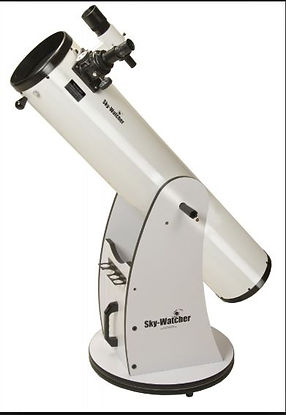
Telescopes
The earliest existing record of a telescope was a 1608 patent submitted to the government in the Netherlands by Hans Lippershey for a refracting telescope. Whether Hans was the actual inventor or just recognised the potential and filed a patent cannot be confirmed or denied.
In 1609 Galileo built his own much improved version and made his telescope observations of celestial objects.
The idea that the objective element could be a mirror instead of a lens was being investigated soon after the invention of the refracting telescope as inventors were looking to improve on image quality.
Making the glass lenses for a refracting telescope was expensive but also very difficult to make a glass without impurities, plus the curvature of the lens resulted in chromatic aberration.
Aberration is the effect produced by the refraction of different wavelengths of light through slightly different angles resulting in a failure to focus correctly.
Parabolic mirrors meant that spherical aberration would be greatly reduced and chromatic aberration could be removed thus improving the image being observed.
In 1688 Isaac Newton built the first practical reflecting telescope, of a design which now bears his name, the Newtonian reflector.


Reflecting / Newtonion
The reflecting telescopes of the time suffered from tarnishing of the mirrors due to the speculum metal (around two thirds copper and one third tin). This remained a problem until the invention of silver plated glass mirrors around 1857 and aluminized mirrors in 1932.
Refracting telescopes were improved in 1733 with the invention of the achromatic lens which partially corrected the color aberrations present in the simpler lens and enabled the construction of shorter, more functional refracting telescopes.
Today modern refracting telescopes have design improvements, normally an additional 1 or 2 lens cells are added to correct aberration. These are known as Doublets or Triplets.. A doublet has two lens cells and a Triplet, three lenses. In addition special coatings are used, "ED" (Extra-low Dispersion) this helps to reduce aberration. although this makes refractors generally more expensive than reflecting telescopes they are never the less a very popular choice for deep sky Astrophotography.
The maximum physical size limit of a refracting lens is about 1 meter (40 inches), the majority of modern day observatory telescopes therefore are of the reflecting design.
Reflecting telescopes of a simpler design can offer more aperture for less money but can be rather large, however they do provide some stunning views of the Moon, Planets and beyond.
The Newtonion telescope became a very popular choice for amateur astronomers when John Dobson in 1965, came up with a simple and inexpensive mounting system now referred to as the Dobsonian Mount or telescope. It is a simple alt-azimuth mount designed for a Newtonian telescope, this meant that larger amateur Newtonian telescopes could be more easily mounted and the hobby took flight.
The largest reflecting telescopes currently have objectives larger than 10m (33 feet) and work is underway on several 30-40m designs.
Telescopes have since taken on many design improvements and telescopes that work in a variety of wavelengths have also been developed, from radio to gamma-rays. the first purpose built radio telescope went into operation in 1937.

Dobsonian mounted telescope
